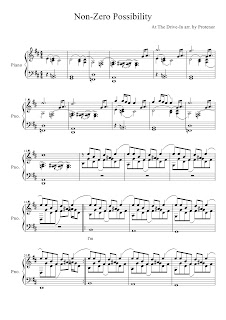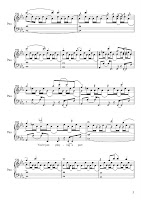






try to build a wall that is high enough: Unlike many Thom Yorke/Radiohead songs, where several meanings and emotions can be read into the song, I believe that is one of the most inherently depressive and angsty songs Thom Yorke has made. It is literally unthinkable for me that somebody might see room for any sort of optimism or relief in this. The hectic electronic beat creates a deeply unsettling background on top of which the billowing synthesizer chords with their disharmonious overlaps unfold a particular disturbing power; it is obvious that something utterly traumatic is being recounted. Personally, I think that the song has lost some of its power in the live version that Thom Yorke plays, for example in the Henry Rollins Show, giving place to something closer to resignation and melancholia; therefore I saw it as a special challenge to try to capture the relentless pulsing of the original version and adapt it to the possibilities of the piano.
The song’s lyrics leave room for a wide range of interpretations – in some forums I have read people attaching meanings from natural disasters such as tsunamis/hurricanes or floods/climate change to war. I particularly liked a comment stating that this was about the end of the world – the song takes on a truly global dimension then, as the end of the world would be something that concerns every single last human being on the planet. However, the line “you should a took me out when you had the chance” clearly signals that whatever the happening, it is to some degree the fault of human beings, at least insofar that they did not act to take out the pending danger that could have been avoided. From what I know about the Third Reich, the lyrics could incidentally be read as a take on the Holocaust (or any instance of genocide) particularly well, too: Many signs of what the Nazis were planning could be noted from early on during their reign, so people started emigrating, warning others to do the same; others who, however, would not “get off the rug”, who tried “to build a wall that is high enough”, ignored the hints of disaster and eventually perished. SA stormtroopers and the SS customarily destroyed Jewish shops and synagogues – especially during the “Kristallnacht”, while the owners would have tried “to save their house”. “Saving their songs” can be interpreted quite literally too, or with the songs representing cultural identity, as much of the Jewish folk song repertoire was lost during the time of the Nazi reign, and only some of it has been recovered by researchers in areas to where Jews had emigrated. The line “try to run, but it follows you up a hill” takes on a particularly gruesome dimension when we think of all the Jews who “tried to run” to Germany’s neighbouring countries, only to be “followed up a hill” when these countries where later invaded by the “Wehrmacht” and further deportations took place. “Ten in a bed” could then refer to either the inhuman conditions in the concentration camps or to accounts of Jews who were hiding in secret cellars and attics; as the line is taken from a children’s song the contrasting new context accounts for an especially shocking juxtaposition. There are many stories of Arians who would not help Jewish people who had been their friends before; these could be the “losers who turned away”. Clearly, the Holocaust as a nightmarish scenario of industrialized mass murder would explain how there can be no room for hope in this song. At the same time I believe that the song’s lyrics are intended to leave room for any kind of interpretation; anybody who has ever written a song before might know how the musician many times starts out with a mood that he seeks to express rather than a definite and clear picture. What is clear though, is that the song deals with some kind of traumatic experience; scientific research has shown that normal experiences are categorized and thereby quasi “filed/made sense of” when stored by our memory, whereas traumatic experience can never be processed in that way and return always with the same intensity and realness as when it was first experienced. Thus, traumatic memories can never belong to the past, but always belong to the present. And clearly, witnessing terrible things happening to “our loved ones” is the one thing in the world that exceeds the sum of all harm that can be inflicted on us ourselves.















